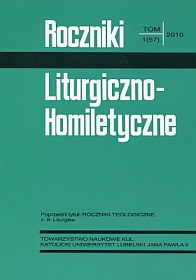The Mystery Nature of Liturgy
Abstract
The mystery nature of liturgy issues from the mystery nature of God’s Revelation that has its height in Jesus Christ. It is in liturgy that Christ’s salutary mystery is actualized. Owing to this, man can participate in Christ’s mystery, and the very mystery achieves its aim. The mystery nature of liturgical celebration is fulfilled in its being a reorientation of Christian life to the mystery of Christ and to participating in it. The mystery character of celebration is also warranted owing to its five dynamisms: remembrance, participation, presence and action of the Holy Spirit, and in consequence the presence and action of Christ-the Church, and reference to the heavenly liturgy. Owing to these dynamisms liturgy is not just educating people and cheering up their hearts, but it is supposed to become the meaning of their lives, an impersonated adoration. The truth about the mystery nature of liturgy is confirmed in the Church’s Tradition and teaching, as well as in the post-Caselian liturgical theology that achieves its most mature form in the Roman school. The mystery character of liturgy should be constantly discovered and emphasized both in ars celebrandi and in ars participandi of liturgy. It consists in the concentration of the Person of Jesus Christ and on the attitude of adoration. If liturgy in its mystery character is a continuation of the mystery of Jesus Christ by its actualization, the care for the mystery character of liturgy is the care for the growth of God’s Kingdom until its fulfillment in the Heavenly Kingdom. Also its language results from the mystery nature of liturgy. The proper and the only permissible language of liturgical celebration is the symbol and the sign, whose special kind is the uttered word.
References
Albanesi N.: La mistagogia. Un modello di teologia sacramentarla. In margine alla seconda edizione dello studio di Enrico Mazza. „Ephemerides liturgicae” 112:1998 s. 174-186.
Bonaccorso G.: Introduzione allo studio della liturgia. Padova 1990.
Catella A.: Dalla costituzione conciliare «Sacrosanctum Concilium» all’enciclica «Mediator Dei». W: La «Mediator Dei» e il Centro di Azione Liturgica: 50 anni alla luce del movimento liturgico. (Bibliotheca Ephemerides litrurgicae. Sectio pastoralis 18). Roma 1998 s. 11-43.
De Clerck P.: Zrozumieć liturgię. Kielce 1997.
Driscoll J.: Theology at the Eucharistic Table. Roma 2003.
Fagerberg D.: What is Liturgical Theology? Collegeville 1992.
Forte B.: Il senso teologico della liturgia. „Rivista Liturgica” 89:2002 s. 1029-1033.
Grillo A.: Alla riscoperta del ruolo fondamentale della liturgia. Recenti contributi teologici su un tema classico. „Ecclesia orans” 16:1999 s. 365-391.
Irwin K.W.: Liturgical Theology. A Primer. Collegeville 1990.
Kavanagh A.: On Liturgical Theology. New York 1984.
Kilmartin E.J.: Christian Liturgy. Theology and Practice. T. 1: Systematic Theology of Liturgy. Kansas City 1988.
Mazza E.: La mistagogia. Una teologia della liturgia in epoca patristica. (Biblioteca «Ephemerides Liturgicae» Subsidia 46). Roma 1988; 19962.
Nadolski B.: Wprowadzenie do liturgii. Kraków 2004.
Schmemann A.: Introduction to Liturgical Theology. New York 1966.
Taft R.F.: Oltre l’oriente e l’occidente. Per una tradizione liturgica viva. Roma 1999.

